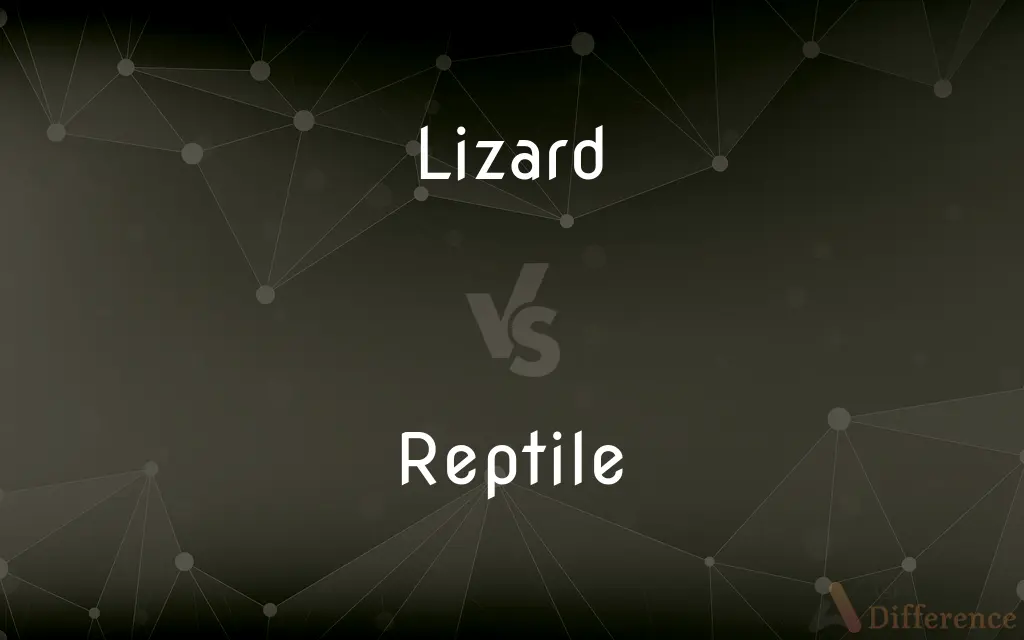Lizard vs. Reptile — What's the Difference?
By Tayyaba Rehman — Updated on October 13, 2023
A Lizard is a type of small to medium-sized reptile, typically with four legs and a tail. Reptile is a broader category, encompassing all cold-blooded vertebrates with scaly skin, including lizards, snakes, and turtles.

Difference Between Lizard and Reptile
Table of Contents
ADVERTISEMENT
Key Differences
Lizards, identified by characteristics like their elongated bodies, tail, and usually four legs, inhabit various ecosystems, showcasing a diverse array of adaptations to different environments. In contrast, Reptiles, as a class, embrace numerous species, including not only lizards but also turtles, snakes, and crocodiles, showcasing a much broader range of biological and physical diversity.
While a Lizard represents a specific subgroup within the reptile class, demonstrating particular features like external ear openings and movable eyelids, the term Reptile delineates a much wider array of creatures. Reptiles are known for attributes such as cold-blooded metabolism, scaly skin, and typically laying shelled eggs, which can be seen across various species within this class, including lizards.
In discussing Lizards, it's essential to highlight that they belong to the order Squamata, which also includes snakes. On the other hand, the term Reptile indicates a class (Reptilia) that consolidates various orders, such as Testudines (turtles), Crocodilia (crocodiles and alligators), and Squamata (lizards and snakes), emphasizing a higher taxonomic level.
Lizards often bear similarities in physical appearance, including generally possessing legs and a definitive neck, which can facilitate identification. In a broader sense, Reptiles showcase more prominent variation in physical attributes, reflecting the adaptation to different habitats, such as marine environments for sea turtles or terrestrial zones for various lizards and snakes.
Acknowledging Lizards, we recognize that they can exhibit a myriad of colors, sizes, and ecological niches, such as the vibrant chameleons or the desert-dwelling bearded dragons. Addressing Reptiles, we encompass a grander spectrum of animals, demonstrating an expansive evolutionary history and biological variation, from the massive crocodiles to the minute geckos.
ADVERTISEMENT
Comparison Chart
Taxonomic Rank
Subset (Order Squamata)
Broader Set (Class Reptilia)
Physical Appearance
Usually has legs and tail
Varies (e.g., legless snakes)
Species Diversity
Limited to lizards
Includes lizards, snakes, turtles, etc.
Size Range
Generally small to medium-sized
Can range from very small to very large
Ecological Niche
Varies within the group
Extremely varied across different orders
Compare with Definitions
Lizard
A cold-blooded vertebrate with scaly skin and movable eyelids.
The Lizard blinked curiously, observing its surroundings with interest.
Reptile
An animal typically laying shelled eggs and breathing through lungs.
The Reptile carefully shielded her eggs, ensuring their safety.
Lizard
A creature often recognized for its ability to shed its tail.
The Lizard swiftly detached its tail to escape the predatory grasp.
Reptile
A creature found globally, adapting to various ecosystems.
The vibrant Reptile thrived in the lush, tropical rainforest.
Lizard
An ectothermic animal often found in warm, terrestrial environments.
The desert Lizard skillfully navigated the sandy dunes.
Reptile
An animal known for a broad variety of sizes and shapes.
The diminutive Reptile slithered, inconspicuous and silent, through the grass.
Lizard
A small to medium-sized, typically four-legged reptile.
The Lizard basked on the rock, soaking up the warm sunlight.
Reptile
Reptiles, as most commonly defined, are the animals in the class Reptilia , a paraphyletic grouping comprising all amniotes except synapsids (mammals and their extinct relatives) and Aves (birds). The class comprises turtles, crocodilians, snakes, amphisbaenians, lizards, tuatara, and their extinct relatives.
Lizard
Lizards are a widespread group of squamate reptiles, with over 6,000 species, ranging across all continents except Antarctica, as well as most oceanic island chains. The group is paraphyletic as it excludes the snakes and Amphisbaenia; some lizards are more closely related to these two excluded groups than they are to other lizards.
Reptile
Any of various usually cold-blooded egg-laying vertebrates often grouped in the class Reptilia, having dry skin covered with scales or horny plates and breathing by means of lungs, and including the snakes, lizards, crocodilians, and turtles. In some classification systems, birds are considered to be reptiles because they are descended from reptilian dinosaurs.
Lizard
Any of numerous squamate reptiles often classified in the suborder Lacertilia, characteristically having a scaly elongated body with a tapering tail, four legs, movable eyelids, and external ear openings.
Reptile
A person regarded as contemptible or obsequious.
Lizard
Leather made from the skin of one of these reptiles.
Reptile
(strictly) A cold-blooded vertebrate of the class Reptilia; an amniote that is neither a synapsid nor a bird; excludes amphibians.
Lizard
Any reptile of the order Squamata that is not a snake or an amphisbaenian, usually having four legs, external ear openings, movable eyelids and a long slender body and tail.
Reptile
A reptile or amphibian.
Lizard
Lizard skin, the skin of these reptiles.
Reptile
(figuratively) A mean or grovelling person.
Lizard
(colloquial) An unctuous person.
Reptile
Creeping; moving on the belly, or by means of small and short legs.
Lizard
(colloquial) A coward.
Reptile
Grovelling; low; vulgar.
A reptile race or crew
Reptile vices
Lizard
(rock paper scissors) A hand forming a "D" shape with the tips of the thumb and index finger touching (a handshape resembling a lizard), that beats paper and Spock and loses to rock and scissors in rock-paper-scissors-lizard-Spock.
Reptile
Creeping; moving on the belly, or by means of small and short legs.
Lizard
(in compounds) A person who idly spends time in a specified place, especially a promiscuous female.
Lounge lizard; lot lizard; beach lizard; truck stop lizard
Reptile
Hence: Groveling; low; vulgar; as, a reptile race or crew; reptile vices.
There is also a false, reptile prudence, the result not of caution, but of fear.
And dislodge their reptile soulsFrom the bodies and forms of men.
Lizard
Any one of the numerous species of reptiles belonging to the order Lacertilia; sometimes, also applied to reptiles of other orders, as the Hatteria.
Reptile
An animal that crawls, or moves on its belly, as snakes,, or by means of small, short legs, as lizards, and the like.
An inadvertent step may crush the snailThat crawls at evening in the public path;But he that has humanity, forewarned,Will tread aside, and let the reptile live.
Lizard
A piece of rope with thimble or block spliced into one or both of the ends.
Reptile
One of the Reptilia, or one of the Amphibia.
Lizard
A piece of timber with a forked end, used in dragging a heavy stone, a log, or the like, from a field.
Reptile
A groveling or very mean person.
Lizard
Relatively long-bodied reptile with usually two pairs of legs and a tapering tail
Reptile
Any cold-blooded vertebrate of the class Reptilia including tortoises turtles snakes lizards alligators crocodiles and extinct forms
Lizard
A man who idles about in the lounges of hotels and bars in search of women who would support him
Reptile
A vertebrate that is cold-blooded and has scaly skin.
The Reptile lay motionless, expertly camouflaged amidst the foliage.
Lizard
A member of the Squamata order, which also includes snakes.
Unlike snakes, this Lizard showcases visibly stubby legs.
Reptile
A member of the class Reptilia, encompassing lizards, snakes, and more.
This Reptile, a massive alligator, lurked stealthily in the murky waters.
Common Curiosities
What does the term Reptile encompass?
A class of vertebrates including lizards, snakes, turtles, and more.
Can a Lizard be considered a Reptile?
Yes, lizards are a subset of reptiles.
What is a Lizard?
A reptile, typically with legs, a tail, and scaly skin.
What is a unique feature of Lizards?
They generally have movable eyelids and external ear openings.
Can Reptiles live in both water and on land?
Yes, different reptile species adapt to varied aquatic and terrestrial habitats.
Are all Reptiles cold-blooded?
Yes, reptiles are generally ectothermic, or cold-blooded.
How many species of Reptiles are there?
There are over 10,000 known species of reptiles.
Is every Reptile a Lizard?
No, reptiles include various animals, not just lizards.
Do Lizards have scales?
Yes, lizards have scaly skin.
How do Reptiles typically reproduce?
They typically lay shelled eggs, though there are exceptions.
What is the habitat of a Lizard like?
Lizards inhabit various environments, from deserts to forests.
Can Lizards detach their tails?
Some lizards can detach their tails as a defense mechanism.
Are Lizards found worldwide?
Lizards are widespread but are most diverse in warmer climates.
Can Lizards regenerate lost body parts?
Some lizards can regenerate tails, but not other body parts.
What is the largest Reptile?
The saltwater crocodile is the largest living reptile.
Share Your Discovery

Previous Comparison
Where vs. Were
Next Comparison
Easygoing vs. FriendlyAuthor Spotlight
Written by
Tayyaba RehmanTayyaba Rehman is a distinguished writer, currently serving as a primary contributor to askdifference.com. As a researcher in semantics and etymology, Tayyaba's passion for the complexity of languages and their distinctions has found a perfect home on the platform. Tayyaba delves into the intricacies of language, distinguishing between commonly confused words and phrases, thereby providing clarity for readers worldwide.















































